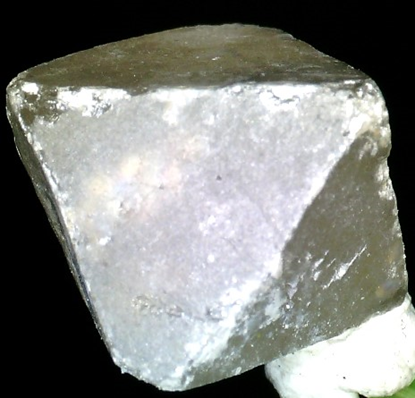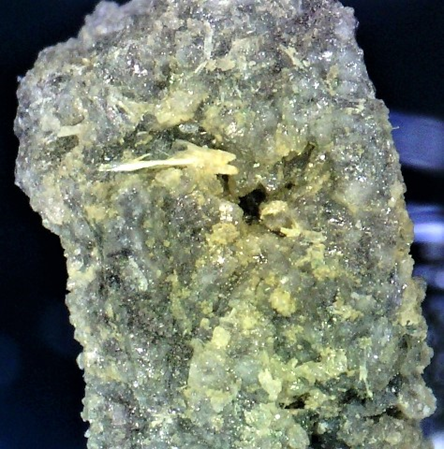In an earlier posting (August 21, 2020) I described my
specimen of senarmontite, an antimony oxide [Sb2O3] that
often appears as nice octahedral crystals (Isometric System). It usually has a gray
to white color or occasionally red to colorless. The colorless
variety is transparent while the others are translucent to mildly
opaque. Although my specimen is a nice octahedron, senarmontite also
occurs as a massive and or granular mineral. Colorless crystals are subvitreous
while others have a resinous luster, but all have a white
streak. The mineral also is quite soft at ~2 or a little more
(Mohs).
The octahedron of translucent senarmontite. Width/length crystal ~7 mm. Specimen collected from the Djebel Hammimat Mine, Ain Babouche District, Oum el Bouaghi Province, Algeria.
It is always interesting as a rockhound to locate
dimorphous minerals, that is minerals with the same chemical formula but
crystalizing in different Crystal Systems. So, I was happy to pick up two
specimens of valentinite, also an antimony oxide with the same chemical formula
as senarmontite [Sb2O3]. However, valentinite is a member
of the Orthorhombic Crystal System and usually appears as flattened prismatic
crystals with complex terminations in fan-shaped aggregates. Most minerals have
an adamantine luster, a white streak, and are colorless to white; collectors
like to locate rarer yellow, pink and brown crystals, However, as in senarmontite,
valentinite may form in granular masses.
The specimen above was collected from the Graf Jost-Christian Mine, Wolfsberg, Sangerhausen, Mansfeld-Sudharz, Saxony-Anhalt, Germany. The mine started extracting antimony ore around 1700. There are tiny acicular crystals on porous quartz crystals. MinDat noted specimens from here are rare. The original label, from Shannon’s Minerals in Tucson was glued on but appears “older,” I remounted the specimen due to the condition of case. Width FOV top is ~9.5 mm. With of bottom specimen ~3.0 mm.
Flat lying radiating sprays of valentinite on a stibnite matrix. Width FOV ~1.7 cm. Collected from Kolarsky vrch deposit, Pezinok, Pezinok District, Bratislava Region, Slovakia. MinDat noted “One of the largest hydrothermal antimony deposits in Slovakia. Small-scale mining of antimony started in 1790 and after some breaks finally stopped in 1991 for economic reasons. The deposit is famous for excellent kermesite specimens. Vein-type antimony deposit, hosted in Late Silurian to Lower Carboniferous phyllites and black slates.”
Both senarmontite and valentinite are secondary minerals and are weathering/alteration products of other antimony-bearing minerals (commonly stibnite) in the oxidized zone of hydrothermal antimony deposits. Associated oxidized minerals often include stibiconite [Sb3+Sb5+O6(OH)], cervantite [Sb3+Sb5+O4], and kermesite [Sb2S2O].
A brief word about dimorphic polymorphism—brief because understanding the exact mechanisms causing such are mostly above my pay grade. I best understand the dimorphs calcite and aragonite (high pressure polymorph). However, aragonite is metastable at the low pressures near the Earth's surface and is thus commonly replaced by calcite. In fact, aragonite is rare or absent in rocks older than ~Mississippian age. Many rockhounds "sort of" understand carbon (hexagonal structure) and diamond (isometric structure) where differing pressure and temperature form different minerals. I "sort of" understand that the dimorphism in senarmontite and valentinite evidently is in response to changes in temperature and pressure during their formation. Senarmontite seems to be metastable; however, I don’t have the slightest idea if there can be a change to valentinite. I just cannot locate appropriate informative literature so will file that problem in “one of life’s persistent questions.”



